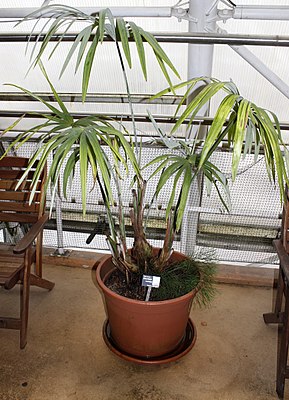Mauritiella aculeata
| Mauritiella aculeata | ||||||||||||
|---|---|---|---|---|---|---|---|---|---|---|---|---|

Mauritiella aculeata |
||||||||||||
| Systematics | ||||||||||||
|
||||||||||||
| Scientific name | ||||||||||||
| Mauritiella aculeata | ||||||||||||
| ( Kunth ) Burret |
Mauritiella aculeata is a South American palm tree .
features
Mauritiella aculeata is a multi-stemmed palm with usually 10 to 50, rarely only 5 stems per adult plant. The trunks reach heights of 5 to 10, rarely up to 20 m. The trunk diameter is 7.5 to 15 cm, rarely only 5 cm. Dead leaves fall off with a clean scar.
The trunks are light, almost white, half-lying, sometimes intertwined, never straight. They often lean out on the surface of the rivers on whose banks they grow. They have small root spines on the lower parts of the trunk . They have small aerial roots at the base .
The silvery glauken , big leaf sheaths form a pseudo-crownshaft. The leaf crown is open due to the long petioles. Their shape is hemispherical to spherical. The crown consists of only a few leaves.
The sheets are folded 61 to 80 times. The petiole is wax-free. The leaf base is peltate and funnel-shaped. The costa is 2 to 3.5, rarely up to 13 cm long. The middle leaf segments are 62 to 87 cm long and 1 to 2 cm wide. The edge of the leaf segments is usually thorny. The leaf segments are pendulous.
In inflorescence there are 9 to 18 female flowers branches, this 11 to 45 cm long. There are 21 to 48 flower-bearing branches (rachillae) per branch.
The fruit measures 4 to 5 × 3 to 4.5 cm. It is elongated, up to 3.8 cm long and olive-colored, reddish-brown when ripe.
The number of chromosomes is 2n = 30.
Distribution and locations
Mauritiella aculeata occurs only in northern South America: in the extreme south of Venezuela , in western Colombia and in northwestern Brazil . The species grows along the banks of the Orinoco and its tributaries at low altitude.
Bernal and Galeano give the sandy soils along the banks of the black water rivers in the area of the upper Rio Negro and the adjacent black water tributaries of the Orinoco and Amazonas as locations .
use
The species is only cultivated in botanical gardens. The pulp is eaten, similar to that of Mauritia flexuosa .
Individual evidence
- ↑ a b c d e Rodrigo Bernal, Gloria Galeano: Notes on Mauritiella, Manicaria and Leopoldinia . Palms, Volume 54, 2010, pp. 119-132.
- ^ A b c d e Robert Lee Riffle, Paul Craft: An Encyclopedia of Cultivated Palms . Timber Press, Portland 2007, ISBN 978-0-88192-558-6 , p. 386.
- ^ Mauritiella aculeata at Tropicos.org. In: IPCN Chromosome Reports . Missouri Botanical Garden, St. Louis
- ^ Francis Kahn: Palms as key swamp forest resources in Amazonia . Forest Ecology and Management, 1991, Volume 38, pp. 133-144, here p. 138.